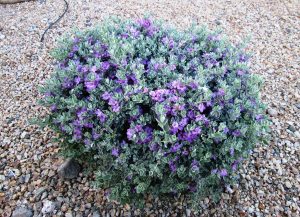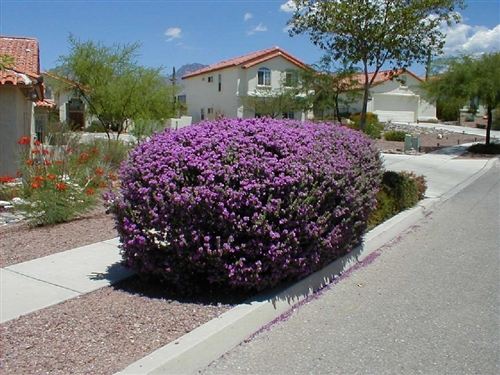We’ve all seen them, those little purple boxes and balls that line the streets and sidewalks of our valley. You may know them as Texas Sage or Texas Rangers and a surprising number of folks seem to be operating under the assumption that they actually grow that way naturally. They do not grow that way and now that we’ve got that firmly established, here’s why pruning them that way is a bad plan for the long run.

Texas sage are Leucophyllums and there are a variety of hybrids available these days. The most commonly planted are the Green Cloud and Silver Cloud, both of which grow to about 6’H x 5-6’W. It’s no wonder people are inclined to try to keep them cut back!
Every time the sage is trimmed to keep the perfectly straight line, the plant forces out leaves and flowers on the tips of any live growth, which creates a dense outer layer of foliage that doesn’t allow light to penetrate through to the lower branches. This leads to that ugly bare wood on the lower branches.

Good news though, if you have a healthy Texas sage with a leafless, woody interior due to this type of pruning, it’s pretty likely you can make it gorgeous again without a lot of trouble.
Radical regenerative pruning
Radical regenerative pruning (RRP) can be performed on healthy Texas Sage in the early spring here in Arizona. Put simply, the process involves cutting the plant back drastically, usually to about 1′ from the ground, while making an effort to leave low-growing foliage wherever possible. Leucophyllums are so durable and fast-growing, you’ll normally see it start to bounce back within a few weeks.
A lot of a plant’s recovery will be determined by the amount of sunlight available and watering patterns. Remember, the Texas sage are very drought-tolerant and don’t like to stay wet all the time, especially if they’re planted in a fair amount of shade.

